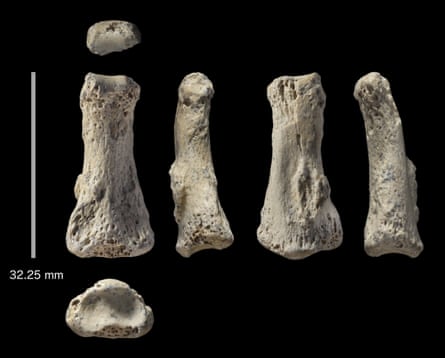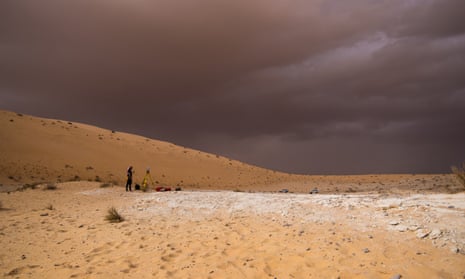A fossilised human finger bone dating to almost 90,000 years ago has been discovered in the Saudi Arabian desert, a find researchers say points to the possibility that our species ventured towards the east far earlier than previously thought.
Until recently, evidence including genetic studies suggested that Homo sapiens migrated out of Africa and into Eurasia in a single, rapid wave about 60,000 years ago. But a number of finds have challenged this “single wave” view, including the discovery of a jawbone in Israel apparently from about 180,000 years ago and fossils from other sites in Israel dating from 90,000-130,000 years ago.
Now researchers say they have unearthed the oldest directly dated human fossil outside of Africa and the eastern Mediterranean region of the Levant, indicating that our species was not only setting up home on the doorstep of Africa early on, but was travelling even further afield up to 25,000 years earlier than expected.
“This discovery of the fossil finger bone is like a dream come true because it supports arguments that our teams have been making for more than 10 years,” said Prof Michael Petraglia of the Max Planck Institute for the Science of Human History, a co-author of the research. “This find, together with other finds in last few years, suggests that modern humans, Homo sapiens, were moving out of Africa multiple times during many windows of opportunity during the last 100,000 years or so.”
The find, the first early modern human fossil to be unearthed in Arabia, also sheds light on the route our species took as it travelled beyond Africa around Southern Asia, suggesting it did not stick to the coast as has previously been suggested. “It shows us that humans were moving across the interior, the terrestrial heart of Eurasia, not along the coastlines,” said Petraglia.
Dr Huw Groucutt, first author of the study, from the University of Oxford, said the find ties in well with the apparent dates of previous fossils turned up in India, East Asia and Sumatra, and with artefacts in Australia dating to 65,000 years ago, as well as previous finds of stone tools in Arabia. That, he said, suggests our species could have passed through Arabia on its way east.
“If you look at any map of the world, when you are looking at Africa and you are looking at the rest of Eurasia, obviously Arabia could be a stepping stone out of Africa,” said Petraglia.
Writing in the journal Nature Ecology & Evolution, the team describe how the finger bone was discovered in northern Arabia in 2016 at a site called Al Wusta in the Nefud desert, with a collection of 380 stone tools nearby suggesting groups of tens of humans would have been living at the site. Crucially, said Groucutt, these stone tools were of an “old-fashioned” type, countering the idea that human migration beyond the Levant was driven by our species developing better technology, with evidence of an ancient lake highlighting that the dispersal was at least partly driven by a changing climate.
The team also found fossilised remains of a host of birds, reptiles and mammals including hippopotamuses.
While it is not clear whether the finger bone is from a man or woman, how old they were when they died or which hand it is from, the team say a careful comparison showed the bone was from our own species and is probably the second bone from the end of the middle finger. Signs of a knobble on the bone, they add, might be the result of manual activity, possibly the stress of making stone tools.
The team were able to date the finger bone directly using a technique known as uranium-series dating. The results put the age of the finger bone at about 88,000 years old – a figure backed up by dating of the associated sediments and animal fossils.
“These animals tell us that when humans were living there it was not a desert, that the site was a lake, a small but permanent perennial freshwater lake, in a grassland setting,” said Groucutt.

Genetic studies suggest that non-Africans today are descended from modern humans who walked out of Africa up to 60,000 years ago, with earlier migrants dying out – possibly due to the impact of Neanderthals, or being overwhelmed by further waves of our own species.It remains unclear whether the Homo sapiens at Al Wusta arrived via the Levant, by crossing the Red Sea or by going around the Red Sea’s southern end – an idea supported by Donald Henry from the University of Tulsa in an accompanying article.
Dr Maria Martinon-Torres, director of the National Research Center on Human Evolution in Spain, said: “With the finding in Al Wusta I would say that presence of Homo sapiens in Asia before 50,000-60,000 years ago is out of doubt, and we can now move on to the next questions: how and why modern humans left Africa and why they took so long to enter Europe.”
